2. 烟台市海洋经济研究院 山东 烟台 264004
2. Yantai Marine Economic Research Institute, Yantai, Shandong 264004, China
近年来,我国的渔业发展普遍受到人为压力、环境污染和产业模式不健全的制约(李雪童等, 2021; 周卫国等, 2021)。传统渔业急需转型,建设海洋牧场成为我国修复海洋生态环境和促进渔业持续发展的重要措施(Zhang et al, 2021)。其中,人工鱼礁作为海洋牧场建设的组成部分,通过改变周围流场来提高水体垂直通量、改善水质、优化营养盐结构(谢斌等, 2017; Lima et al, 2019),为海洋动、植物提供良好的繁殖、生长环境,达到保护与改善海洋生态环境、增殖养护渔业资源等目的(王佳琦等, 2018; 王新萌等, 2019; 印瑞等, 2019)。
目前,我国海洋牧场主要专注于渔业增殖和休闲产业化(李忠义等, 2019),综合利用效率不高且缺乏科学规划,用海方式单一且作业方式驳杂(岳奇等, 2020)。国外关于海洋牧场的研究主要集中在生态系统修复(Lee et al, 2014)、渔业资源增殖(Tanaka et al, 2015)、能量流动及管理调控等方面。我国相关研究主要集中在渔业资源评估(方光杰等, 2018)、海洋牧场选址(曾旭等, 2018)、生态系统健康评价(赵荣荣等, 2019)及水质分析(王伟定等, 2010)等,对海洋牧场建成后的开发利用与综合管理的研究鲜有报道。营养盐含量作为重要的自然环境因素,是海水中浮游植物生长的基本生源要素,与初级生产力、陆源输入等密切相关,一直被广泛研究(徐东会等, 2017; 梁洲瑞等, 2019),但对海洋牧场的营养盐分布特征与海洋牧场区开发管理规划相结合的研究较少。了解营养盐的空间分布特征,能为调整海洋牧场不同功能区的构建及布局提供参考(彭璇等, 2014),并制定可持续性海洋牧场开发规划与管理政策。
传统的适宜性分析与评价方法已广泛应用于城市建设用地、农业用地和自然保护区的规划与布局管理(尹海伟等, 2013; 孙倩雯等, 2020)。在海洋牧场建设中,适宜性分析与评价主要应用于人工鱼礁的选址与生态系统健康评价等方面(曾旭等, 2018; 赵荣荣等, 2019),而在增养殖活动的规划与布局上未见应用。网箱及筏架养殖不仅是山东省最常见的增养殖模式,也是海洋牧场建设的重要内容。邱明等(2018)和林勇等(2014)分别探究了深水网箱和虾夷扇贝(Patinopecten yessoensis)的增养殖适宜性,但网箱及筏架等增养殖设施在海洋牧场中的科学合理布局仍处于初步探索阶段。
本研究通过对小竹山岛海洋牧场区4个航次的季度调查,探究水体营养盐含量分布特征,并对海洋牧场建成后开展网箱及筏式增养殖活动进行适宜性评价,以期为探究海洋牧场生态环境分布状况及开发利用管理提供依据。
1 材料与方法 1.1 采样时间和站位布设小竹山岛海洋牧场区面积为146.1 hm2,2017年6月在海区中央投放人工构件礁24座,共计12 000 m3,周围辐射分布石块礁、小圆石、砂砾、泥等底质类型。于2017年12月(冬季)在小竹山岛海域采样11个站位,2018年5月(春季)、9月(夏季)和11月(秋季)各采样9个站位,共计4个航次。人工鱼礁投放区域为海区中心,每航次调查以海区中心为原点,设置200 m、200~400 m和400 m外3个样带,采用分层随机采样法。具体站位如图 1所示。

|
图 1 采样站位 Fig.1 Sampling station |
采样和分析方法按照海洋调查规范(GB/T12763-2007)、海洋监测规范(GB/17378-2007)进行。各调查站位采样层次分为表层、5 m、10 m和底层;温度、盐度、pH、溶解氧(DO)由YSI多参数水质仪(Proplus)测得;沉积物粒度利用Mastersizer 2000激光粒度仪进行测量;透明度在现场用透明度盘测得;化学需氧量(COD)、硅酸盐(SiO3-Si)、活性磷酸盐(DIP)、溶解无机氮(DIN)和叶绿素a (Chl a)等参数于现场采样后在实验室测得。
1.3 数据分析 1.3.1 营养盐分布特征营养盐平面分布范围为整个小竹山海洋牧场区;4个航次均在海流为西北流向时采样,为了探究水流流向对营养盐分布的影响,营养盐剖面选取从中心区域(人工鱼礁投放区域)到西北区域,呈中心–西北走向(图 1)。通过营养盐平面分布得到整个海区表层、5 m、10 m和底层的营养盐浓度值,在4个水层中根据剖面位置每间隔20 m选取插值点组合成剖面,并二次插值生成4个季度的营养盐浓度剖面图。营养盐平面分布及剖面分布特征图采用Golden Software Surfer 14.0绘制。
1.3.2 增养殖适宜性评价对虾夷扇贝和深水网箱增养殖进行适宜性评价,选取海水营养水平指数(E)、Chl a (mg/L)、温度(℃)、盐度、水深(m)和底质类型等评价指标,并对评价指标进行标准分值划分(表 1和表 2),其中,“5”为最适宜,“1”为最不适宜。以上评价指标的分级标准及权重引用隋传国(2018)的研究。各站位评价指标选取4个水层的平均值,计算不同季节虾夷扇贝及深水网箱增养殖适宜性指数,并绘制分季节增养殖适宜性分布图,将4个季节虾夷扇贝及深水网箱增养殖适宜性分布图中各点对应的数据相加,得到全年虾夷扇贝及深水网箱增养殖适宜性指数,并绘制全年增养殖适宜性分布图。使用Excel 2017对数据进行统计分析,增养殖适宜性分布图采用Golden Software Surfer 14.0进行绘制。
|
|
表 1 虾夷扇贝养殖适宜性评价指标分级标准及权重 Tab.1 Evaluation criteria and weight for the suitability evaluation index of aquaculture of scallop (P. yessoensis) |
|
|
表 2 深水网箱养殖适宜性评价指标分级标准及权重 Tab.2 Evaluation criteria and weight for the suitability evaluation index of aquaculture of deep-sea cage culture |
海水营养水平指数(EI)计算公式为:
| $ {\text{EI}} = \frac{{{\text{COD}} \times {\text{DIP}} \times {\text{DIN}} \times {{10}^6}}}{{4500}} $ |
小竹山岛海洋牧场区DIP浓度变化范围为0.01~0.038 mg/L。DIP浓度冬季 > 夏季 > 秋季 > 春季,分别为0.032、0.021、0.017和0.015 mg/L (图 2)。在水层分布上,冬季表层DIP浓度最高,为0.031 mg/L,东部海域高于西部海域;春季、夏季和秋季DIP浓度均呈现由中心向外扩散的趋势,例如春季,由中心区域0.017 mg/L的浓度逐渐向四周扩散降低至0.012 mg/L。冬季5 m水层DIP浓度除了在中心海域附近及西北部分海域出现较低值(0.027 mg/L)外,其余海域浓度值都较高;秋季DIP浓度呈现由海区东部(0.021 mg/L)向西部(0.013 mg/L)逐渐降低的趋势。春季和夏季DIP浓度变化不显著,分布较为均匀。10 m水层DIP浓度在冬季呈现由中心海域(0.031 mg/L)向南部海域(0.036 mg/L)逐渐增高的趋势,而春季和秋季分布均匀。冬季底层DIP浓度在海区中心出现最高值,为0.032 mg/L;春季DIP浓度由西北区域的0.023 mg/L向东南海域迅速下降至0.010 mg/L;夏季和秋季DIP浓度变化不大,整个海洋牧场区分布较为均匀。对于10 m和底层2个水层,4个季节中均会在海区中心出现较高的浓度值。
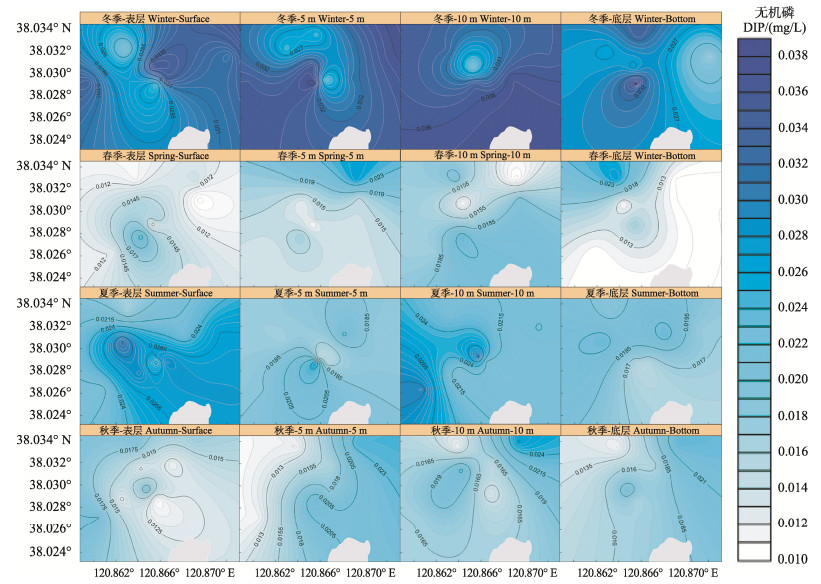
|
图 2 活性磷酸盐的平面分布 Fig.2 Planar distribution of DIP |
小竹山岛海洋牧场区DIN浓度变化范围为0.08~0.38 mg/L。DIN浓度秋季 > 冬季 > 夏季 > 春季(图 3)。在水层分布上,4个季节中,表层DIN浓度都有明显的高值区域,冬季、春季和秋季小竹山岛海洋牧场区西北部海域DIN浓度较高,夏季东部海域DIN浓度较高;夏季表层DIN浓度由东部海域(0.29 mg/L)向西部降低至0.19 mg/L。5 m水层,秋季DIN浓度最高,为0.25 mg/L,由中心区域的0.12 mg/L向四周逐渐增大至0.29 mg/L;春季和夏季DIN浓度呈现从中心向海域四周逐渐降低的趋势。10 m水层,秋季DIN浓度为0.27 mg/L,浓度最高值出现在海区西北部(0.34 mg/L),并向东部逐渐降低;冬季、春季和夏季DIN浓度最高点均出现在中心区域,其他区域浓度较为一致,没有明显的变化趋势。底层,秋季DIN浓度最高并呈现由中心(0.09 mg/L)向外逐渐升高的趋势;春季和夏季DIN浓度最高值均出现在中心区域,整体上呈现由中心区域向外逐渐递减的趋势。
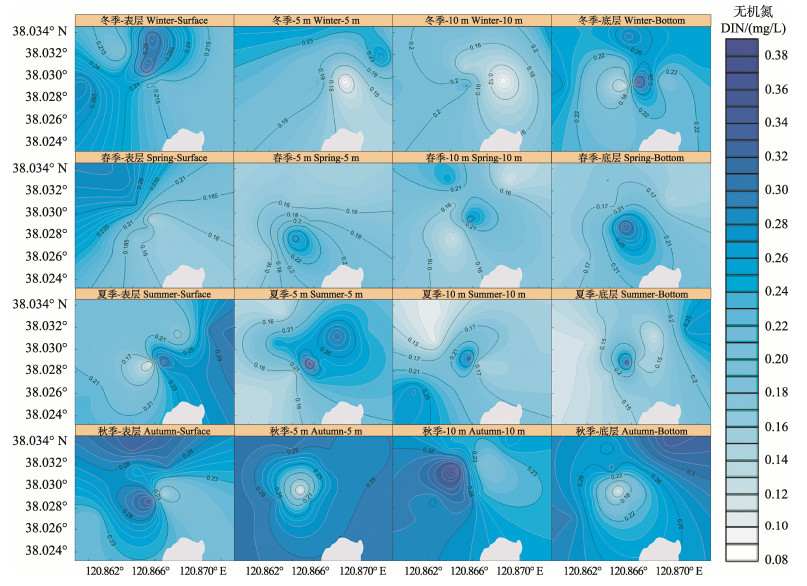
|
图 3 无机氮的平面分布 Fig.3 Planar distribution of DIN |
DIP浓度的剖面分布与平面一致(图 4)。冬季DIP浓度最高,水体混合均匀,没有明显的水平或垂直分布趋势;春季DIP浓度在深水区有明显的分层现象,DIP浓度表层低(0.017mg/L),底层高(0.023 mg/L),在水深较浅区域DIP浓度分布均匀;夏季DIP浓度有水平分层现象,表层低(0.019mg/L),底层高(0.023 mg/L);秋季DIP浓度在垂直方向上差异不大,水体浓度分布均匀。
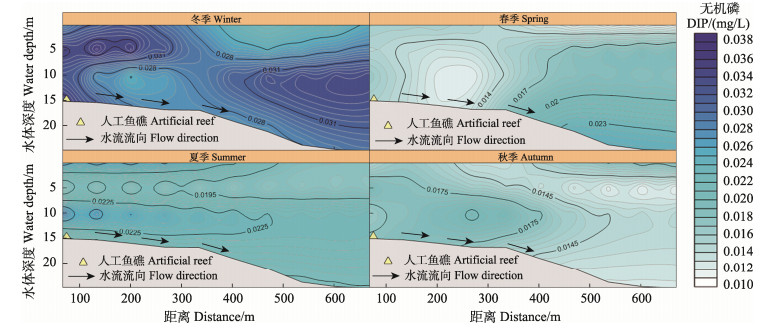
|
图 4 活性磷酸盐的剖面分布 Fig.4 Profile distribution of DIP |
DIN浓度的剖面分布与平面一致,DIN浓度最高值出现在秋季(图 5)。冬季表层和底层水体DIN浓度较高(0.023 mg/L),中层水体浓度较低(0.018 mg/L)。春季在表层和中层水体有较高的DIN浓度(0.220 mg/L),水体混合均匀,无明显分层现象。夏季DIN浓度分布在水深较浅区域有垂直分布现象,水深较深处浓度低且混合均匀(0.09 mg/L)。秋季DIN浓度较高值出现在水体中层,水体混合均匀,无明显的水平和垂直分布趋势。
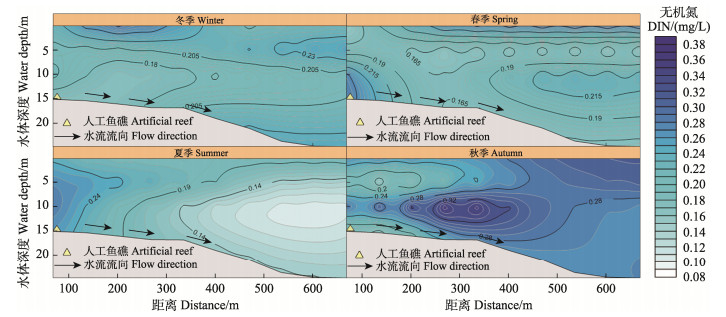
|
图 5 无机氮的剖面分布 Fig.5 Profile distribution of DIN |
小竹山岛海洋牧场区虾夷扇贝分季节增养殖适宜性指数在2.70~3.85之间,适宜性指数具有较大的时空变异(图 6A~D)。冬季适宜虾夷扇贝增养殖区域距小竹山岛西北方向约500~1300 m,夏季适宜虾夷扇贝增养殖区域距小竹山岛西北方向约650~1300 m,适宜性指数高于3.50。同时,在中心海域附近也出现较高值3.20。春季适宜性指数高值为3.50,分布于海域中心,整体分布均匀,适宜性指数在3.10~3.60之间,但较冬季、夏季两季低。秋季适宜性指数低,范围为2.80~3.30,为4个季节中最低,较不适宜进行虾夷扇贝养殖活动。小竹山岛海洋牧场区虾夷扇贝全年增养殖适宜性指数在12.8~14.2之间,适宜在西北海域进行虾夷扇贝增养殖活动,该海域距小竹山岛西北方向最近距离约700 m,最远距离约1300 m,适宜性指数均高于13.6 (图 6E)。虾夷扇贝增养殖适宜性评价中,叶绿素a及富营养化指数适宜性数值占比较高(表 3),其中,叶绿素a适宜性数值为夏季 > 冬季 > 秋季 > 春季,富营养化指数适宜性数值为春季=夏季 > 冬季 > 秋季。
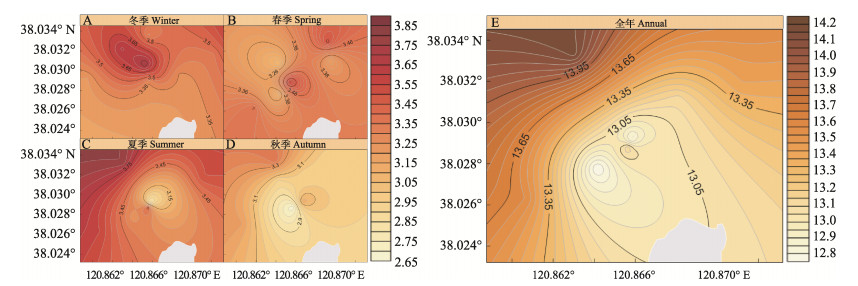
|
图 6 虾夷扇贝增养殖适宜性指数 Fig.6 Cultivation suitability index of scallop (P. yessoensis) |
|
|
表 3 不同季节虾夷扇贝增养殖适宜性评价指标的适宜性数值 Tab.3 Value for the suitability evaluation index of aquaculture of scallop P. yessoensis in different seasons |
小竹山岛海洋牧场区深水网箱分季节增养殖适宜性指数在2.70~3.80之间,适宜性指数具有较大的时间差异(图 7A~D)。夏、秋两季深水网箱适宜性指数较高,最大值均分布于西北海域,距小竹山岛西北方向约650~1300 m,且秋季适宜性指数在海域中心区域附近也出现较大值3.20。春季适宜性指数在2.90~3.50之间,整体分布均匀,最大值3.40分布于中心海域,但与夏、秋两季相比较低。冬季适宜性指数整体较低,除西北部海域适宜性指数较高外,其他海域较低;冬季适宜性指数低于其他季节,较不适宜进行深水网箱养殖活动。小竹山岛海洋牧场区深水网箱全年增养殖适宜性指数在12.0~13.6之间,适宜在西北海域进行深水网箱增养殖活动,距小竹山岛西北方向最近距离约为650米,最远距离为1300 m,适宜性指数均高于12.9 (图 7E)。深水网箱增养殖适宜性评价中,叶绿素a及富营养化指数适宜性数值占比较高(表 4),其中,叶绿素a适宜性数值为夏季 > 冬季 > 秋季 > 春季,富营养化指数适宜性数值为春季=夏季 > 秋季 > 冬季。

|
图 7 深水网箱增养殖适宜性指数 Fig.7 Cultivation suitability index of deep-sea cage culture |
|
|
表 4 不同季节深水网箱增养殖适宜性评价指标的适宜性数值 Tab.4 Value for the suitability evaluation index of aquaculture of deep-sea cage culture in different seasons |
本研究对小竹山岛海洋牧场区进行了4个航次的季度调查,分别探究了DIP和DIN的分布特征。小竹山岛海洋牧场区营养盐含量在不同季节间具有显著差异,季节内分布均匀。陈聚法等(2016)研究发现,渤海中部DIP含量由高到低依次为冬季、秋季、春季及夏季,DIP垂直分布呈现均匀状态,与本研究营养盐平面与剖面分布特征一致;同时,本研究中DIP浓度在冬季同样出现最高值,可能是由于冬季太阳辐射明显减弱,海水温度迅速下降,浮游生物生长对营养盐的摄取速率降低导致的(张乃星等, 2011)。而渤海海峡水交换呈现夏强冬弱的特点(冀承振等, 2019),导致小竹山岛海洋牧场区冬季水体交换较差,表层与底层营养盐交换受阻,从而出现垂直分布差异(黄宏等, 2017)。本研究中,春季和秋季水体DIP分布均匀,这与渤海海峡水动力特征有关,小竹山岛海域处于黄渤海交界处,受到辽河流域、海河流域以及黄河流域三大水系径流的影响,同时作为水体交换通道,海流活动频繁,水体交换较快,导致营养盐分布较为均匀(张乃星等, 2011; 张海波等, 2019)。
张海波等(2020)研究发现,渤海中部DIN由夏季的(7.78±7.38) μmol/L升至秋季的(14.84±6.20) μmol/L,增幅达1.9倍。赵晨英等(2016)指出,黄渤海秋季水体的DIN含量最高;本研究结果显示,秋季DIN含量明显高于其他季节,这与其研究结果一致。可能由于秋季入海径流量减少,冲淡水现象减弱,同时,消亡的浮游生物逐渐矿化释放营养盐(张海波等, 2019)。此外,DIN的季节、空间差异与所在海域陆源径流氮输入、微生物的转化作用及沉积物–水界面氮释放等相关。
公丕海等(2019)研究发现,人工鱼礁周围及内部存在上升流区等有显著特征的区域。本研究发现,DIP和DIN在10 m及底层水体的人工鱼礁投放区域都有较高的浓度值,这可能与人工鱼礁产生的上升流有关;同时,由于地形坡度较大,水流将地势较低处的营养盐携带至地势较高的人工鱼礁投放区域,二者共同作用导致在人工鱼礁投放区域中下层水体形成较高的营养盐浓度。李延伟等(2013)对北黄海3个断面进行了研究,各断面营养盐的垂直分布层化现象明显,深水区底层浓度高。本研究中,深水区同样出现较高的营养盐浓度,但垂直分布上没有明显的层化现象。而深水区底层营养盐含量高与水深密切相关,较深的水深会导致营养盐在底部沉积(赵建华等, 2015)。本研究与上述研究相比,所选取的剖面在空间尺度上相对较小,并且受到水体交换频繁及陆源径流的影响,从而营养盐浓度分布均匀。
3.2 增养殖适宜性评价评价指标的选取对于具体的增养殖活动及增养殖对象的适宜性评价有着至关重要的作用。Radiarte等(2009)对芬卡湾日本扇贝(Mizuhopecten yessoensis)增养殖适宜地点进行探究,选取了海水温度、叶绿素a浓度、悬浮物浓度和水深4个指标;林勇等(2014)对大小长山岛虾夷扇贝增养殖适宜性进行了研究,选取了叶绿素a浓度、海水表面温度以及评价单元到渔港、城镇、旅游区距离等指标。本研究同样将海水温度、叶绿素a浓度和水深等指标纳入适宜性评价;同时,富营养化指数是评价海水水质的重要指数,已被广泛应用于海域环境状况的评估(王以斌等, 2015),而本研究中富营养化指数不再作为一个独立参数来描述小竹山岛海洋牧场区的富营养化情况,而是将其作为一个指标纳入适宜性评价,同时结合其他调查数据进行适宜性评价。
邱明等(2018)通过深水网箱自然属性及社会属性适宜性研究发现,长海县适宜网箱增养殖的区域分布于广鹿岛与格仙岛西部、獐子岛南部等海域;小竹山岛海洋牧场区与长海县同处渤海海峡,研究表明, 小竹山岛海洋牧场区适宜深水网箱增养殖区域分布于西北海域,原因在于西北海域水深较深且底质柔软平缓,有利于进行深水网箱的开发利用。社会属性参数是适宜性评价中的一项重要指标,而小竹山岛海洋牧场区与上述研究区域相比,尺度小,距渔港距离等社会属性参数并没有显著差异,因此未纳入考量。本研究中,深水网箱增养殖的适宜性评价主要考虑的是自然环境条件,并没有将具体的增养殖对象纳入考虑范围。而在实际生产中,深水网箱增养殖物种十分丰富(石建高等, 2021),因此,在进行网箱增养殖时,可以依据增养殖物种的生活习性有针对性地进行指标的划分范围及权重的分配(沈伟良等, 2017)。
本研究中,虾夷扇贝及深水网箱增养殖活动适宜性主要受限于海区的叶绿素a浓度和富营养化指数。董世鹏等(2010)研究发现,叶绿素a浓度是影响浮游生物量的重要因素,同时,浮游生物是增养殖对象主要的食物来源之一(齐占会等, 2021)。本研究中,冬季及夏季叶绿素a浓度高,导致浮游生物量充足,从而为增养殖活动提供大量的食物来源,适宜开展增养殖活动。富营养化指数是衡量海域富营养化程度的重要指标(王以斌等, 2015),而海水富营养化会使水体理化性质发生改变,氮磷比失衡,从而破坏海洋生态系统(施沁璇等, 2021)。本研究中,冬季富营养化指数高,可能会导致赤潮及重金属毒物的暴发(白怀宇等, 2018),并造成海水中溶解氧浓度降低,从而阻碍增养殖物种的生长(李妙聪等, 2021),因此,不适宜进行增养殖活动。春季、夏季和秋季富营养化指数较低,保证水体充足的营养物质,同时,不改变水体的理化性质,为增养殖物种栖息与生长提供良好的外部环境,有利于养殖活动的开展。本研究分季节对虾夷扇贝及深水网箱的增养殖适宜性进行了探讨,结果表明,虾夷扇贝及深水网箱增养殖适宜区域存在季节差异,而增养殖设施投产后难以移动,因此,增养殖活动的选址较难确定。为了实际应用,本研究又进行了全年虾夷扇贝及深水网箱增养殖适宜性评价,并得到全年的增养殖适宜性指数,可为增养殖活动选址提供依据,并为海洋牧场科学合理地使用海域空间资源、提高经济收益提供科学参考,更具实际意义。
同时,人工鱼礁的投放与增养殖活动的适宜性息息相关。赵荣荣等(2019)对长岛挡浪岛人工鱼礁区生态系统进行了健康评价,结果显示,人工鱼礁区生态系统比对照区生态系统更加稳定;人工鱼礁的投放已经被证明对周围海域具有辐射性,且在一定程度上带动了生态环境的改善,因此,很好地解释了在不同季节虾夷扇贝及深水网箱增养殖适宜性评价中,人工鱼礁投放区域及周围海域会出现很高的适宜性指数;而在全年的虾夷扇贝及深水网箱适宜性评价中,人工鱼礁投放区域并未出现高值,可能是由于人工鱼礁投放时间较短,对生态环境的改善不稳定且不充分。
BAI H Y, LI Q F, ZHANG Y, et al. Seasonal variation in nutrients and evaluation of eutrophication in the aquaculture areas in the middle water areas of Xiangshan Harbor. Progress in Fishery Sciences, 2018, 39(6): 24-30 [白怀宇, 李秋芬, 张艳, 等. 象山港中部养殖海区营养盐的季节变化及富营养化. 渔业科学进展, 2018, 39(6): 24-30] |
CHEN J F, ZHAO J, GUO F, et al. Recent temporal and spatial variation in active phosphate concentration in seawater of the central Bohai Sea. Progress in Fishery Sciences, 2016, 37(4): 28-35 [陈聚法, 赵俊, 过锋, 等. 近年渤海中部海域活性磷酸盐的时空变化特征. 渔业科学进展, 2016, 37(4): 28-35] |
DONG S P, LIN F, JIANG W W, et al. Estimation of carrying capacity of manila clam (Ruditapes philippinarum) in Jiaozhou Bay based on spatial and temporal distribution of chlorophyll a. Progress in Fishery Sciences, 2020, 41(6): 100-107 [董世鹏, 蔺凡, 姜娓娓, 等. 基于叶绿素a时空分布的胶州湾菲律宾蛤仔养殖容量评估. 渔业科学进展, 2020, 41(6): 100-107] |
FANG G J, SUN L Y, TANG Y L, et al. A comparative study on fishery resource of artificial reefs based on gillnet and cage catches. Periodical of Ocean University of China (Natural Science), 2018, 48(S1): 23-33 [方光杰, 孙利元, 唐衍力, 等. 基于刺网和地笼渔获物的人工鱼礁区资源丰度比较研究. 中国海洋大学学报(自然科学版), 2018, 48(S1): 23-33] |
GONG P H, ZHENG Y X, LI J, et al. Flow field effect and stability of the equilateral tower-type truss artificial reef. Journal of Fishery Sciences of China, 2019, 26(5): 1021-1028 [公丕海, 郑延璇, 李娇, 等. 塔型桁架人工鱼礁流场效应及稳定性. 中国水产科学, 2019, 26(5): 1021-1028] |
HUANG H, LI D P, ZHANG Y, et al. Effects of artificial reefs deploymenton nutrients in the marine farming zone of Haizhou Bay. Acta Scientiae Circumstantiae, 2017, 37(8): 2854-2861 [黄宏, 李大鹏, 张岩, 等. 海州湾海洋牧场人工鱼礁投放对营养盐的影响. 环境科学学报, 2017, 37(8): 2854-2861] |
JI C Z, LI G, YU B, et al. The multi-time scale variations of water exchange across the Bohai Strait. Oceanologia et Limnologia Sinica, 2019, 50(1): 24-30 [冀承振, 黎舸, 于博, 等. 渤海海峡水交换多时间尺度变化特征研究. 海洋与湖沼, 2019, 50(1): 24-30] |
LEE S G, MIDANI A R. National comprehensive approaches for rebuilding fisheries in South Korea. Marine Policy, 2014, 45: 156-162 DOI:10.1016/j.marpol.2013.12.010 |
LI M C, LIU W S, JIANG J H. Analysis of spatial-temporal variation and nutritional status of environmental quality in the mariculture zone at the Yueqing Bay. Marine Environmental Science, 2021, 40(5): 724-731 [李妙聪, 刘文胜, 江锦花. 乐清湾海水养殖环境水质质量时空变化及富营养化状况评价. 海洋环境科学, 2021, 40(5): 724-731] |
LI X T, WANG K, XU B D, et al. Annual variation of species composition and spatial structure of fish community in Shandong offshore. Journal of Fisheries of China, 2021, 45(4): 552-562 [李雪童, 王琨, 徐宾铎, 等. 山东近海鱼类群落种类组成与空间结构的周年变化. 水产学报, 2021, 45(4): 552-562] |
LI Y W, HU Y Y, CHEN S M, et al. Distribution and influence factors of nutrients in the North Yellow Sea in summer and autumn. China Environmental Science, 2013, 33(6): 1060-1067 [李延伟, 胡莹莹, 陈淑梅, 等. 夏、秋季北黄海营养盐的时空分布特征及其影响机制. 中国环境科学, 2013, 33(6): 1060-1067 DOI:10.3969/j.issn.1000-6923.2013.06.014] |
LI Z Y, LIN Q, LI J, et al. Present situation and future development of marine ranching construction in China. Journal of Fisheries of China, 2019, 43(9): 1870-1880 [李忠义, 林群, 李娇, 等. 中国海洋牧场研究现状与发展. 水产学报, 2019, 43(9): 1870-1880] |
LIANG Z R, SUN T Q, WANG W J, et al. The temporal and spatial distribution characteristics of the nutrients and community structures of phytoplankton and their relationships in the pyropia culture areas of Rizhao, China. Progress in Fishery Sciences, 2019, 40(5): 78-88 [梁洲瑞, 孙藤芹, 汪文俊, 等. 日照紫菜养殖海域营养盐的时空分布特征及其与浮游植物群落结构的相关性分析. 渔业科学进展, 2019, 40(5): 78-88] |
LIMA J S, ZALMON I R, LOVE M, et al. Overview and trends of ecological and socioeconomic research on artificial reefs. Marine Environmental Research, 2019, 145: 81-96 |
LIN Y, LIU S X, GUAN D M, et al. GIS-based Japanese scallop (Patinopecten yessoensis) aquaculture suitability assessment: A case study with the islands of Dachangshan and Xiaochangshan, North Yellow Sea, China. Acta Ecologica Sinica, 2014, 34(20): 5984-5992 [林勇, 刘述锡, 关道明, 等. 基于GIS的虾夷扇贝养殖适宜性综合评价——以北黄海大小长山岛为例. 生态学报, 2014, 34(20): 5984-5992] |
PENG X, MA S W, CHEN H G, et al. Spatial distribution and assessment of nutrients in marine ranching in Zhelin Bay- Nanao Island in summer. South China Fisheries Science, 2014, 10(6): 27-35 [彭璇, 马胜伟, 陈海刚, 等. 夏季柘林湾–南澳岛海洋牧场营养盐的空间分布及其评价. 南方水产科学, 2014, 10(6): 27-35] |
QI Z H, SHI R J, YU Z H, et al. Review of influences of filter-feeding bivalves aquaculture on planktonic community. South China Fisheries Science, 2021, 17(3): 115-121 [齐占会, 史荣君, 于宗赫, 等. 滤食性贝类养殖对浮游生物的影响研究进展. 南方水产科学, 2021, 17(3): 115-121] |
QIU M, ZHANG Y, SUI C G, et al. Suitability evaluation of deep water cage aquaculture based on GIS taking Changhai County as an example. Journal of Fisheries Research, 2018, 40(6): 449-457 [邱明, 张燕, 隋传国, 等. 基于GIS的深水网箱养殖适宜性评价——以长海县为例. 渔业研究, 2018, 40(6): 449-457] |
RADIARTA I, SAITOH S I. Biophysical models for Japanese scallop, Mizuhopecten yessoensis, aquaculture site selection in Funka Bay, Hokkaido, Japan, using remotely sensed data and geographic information system. Aquaculture International, 2009, 17(5): 403-419 |
SHEN W L, WU X F, SHENTU J K, et al. The effects of different diets and culture environments on the morphological variations in the large yellow croaker (Larimichthys crocea). Progress in Fishery Sciences, 2017, 38(6): 70-77 [沈伟良, 吴雄飞, 申屠基康, 等. 不同饵料及养殖环境对大黄鱼(Larimichthys crocea)形态差异的影响. 渔业科学进展, 2017, 38(6): 70-77] |
SHI J G, YU W W, LU B C, et al. Development status and prospect of Chinese deep-sea cage. Journal of Fisheries of China, 2021, 45(6): 992-1005 [石建高, 余雯雯, 卢本才, 等. 中国深远海网箱的发展现状与展望. 水产学报, 2021, 45(6): 992-1005] |
SHI Q X, HAO G J, YE T, et al. Research on eutrophication and its driving factors in reservoirs of the Quzhou Area. Progress in Fishery Sciences, 2021, 42(1): 18-28 [施沁璇, 郝贵杰, 叶霆, 等. 衢州地区渔业水域水库水体富营养化水平及驱动因子研究. 渔业科学进展, 2021, 42(1): 18-28] |
SUI C G. Research on the suitability zoning of aquaculture based on GIS. Masterxs Thesis of Dalian Ocean University, 2018, 39 [隋传国. 基于GIS的养殖用海适宜性分区研究. 大连海洋大学硕士研究生学位论文, 2018, 39] |
SUN Q W, LIU H, SHANG W T, et al. GIS-based assessment for culture suitability of kelp (Saccharina japonica) in Sanggou Bay and the surrounding waters. Progress in Fishery Sciences, 2020, 41(1): 41-50 [孙倩雯, 刘慧, 尚伟涛, 等. 基于GIS的桑沟湾及周围海域海带养殖适宜性评价. 渔业科学进展, 2020, 41(1): 41-50] |
TANAKA T, OTA Y. Reviving the Seto Inland Sea, Japan: Applying the principles of Satoumi for marine ranching project in Okayama. Marine Productivity: Perturbations and Resilience of Socio-Ecosystems, 2015 |
WANG J Q, LIU S D, TANG Y L, et al. Growth, mortality and resource evaluation of Hexagrammos otakii inhabiting the artificial reef area of Lidao, Shandong Province. Periodical of Ocean University of China, 2018, 48(11): 51-59 [王佳琦, 刘淑德, 唐衍力, 等. 山东俚岛人工鱼礁区大泷六线鱼生长、死亡及资源评价. 中国海洋大学学报(自然科学版), 2018, 48(11): 51-59] |
WANG W D, LIANG J, ZHNAG S Y, et al. Influence of artificial reef construction on nutrition and water quality in off-shore area of Shengsi, Zhejiang. Acta Hydrobiologica Sinica, 2010, 34(1): 78-87 [王伟定, 梁君, 章守宇, 等. 人工鱼礁建设对浙江嵊泗海域营养盐与水质的影响. 水生生物学报, 2010, 34(1): 78-87] |
WANG X M, SHENG H X, LIU S D, et al. Distribution characteristics of Liza haematocheila and its relationship with environmental factors in Furongdao artificial reef zones, Laizhou Bay, China. Journal of Fisheries of China, 2019, 43(9): 1914-1924 [王新萌, 盛化香, 刘淑德, 等. 莱州湾芙蓉岛人工鱼礁区鰉资源分布特征及其与环境因子的相关性分析. 水产学报, 2019, 43(9): 1914-1924] |
WANG Y B, ZHANG A J, ZHAO X L, et al. Evaluation and changing trend analysis on coastal seawater quality status of Guangxi Tieshan Port. Environmental Science and Technology, 2015, 38(S2): 357-364 [王以斌, 张爱军, 赵晓龙, 等. 广西铁山港海域环境现状分析评价及变化研究. 环境科学与技术, 2015, 38(S2): 357-364] |
XIE B, ZHANG S, LI L, et al. Community structure of phytoplankton in the sea farming of Haizhou Bay and its relationships with environmental factors. Acta Scientiae Circumstantiae, 2017, 37(1): 121-129 [谢斌, 张硕, 李莉, 等. 海州湾海洋牧场浮游植物群落结构特征及其与水质参数的关系. 环境科学学报, 2017, 37(1): 121-129] |
XU D H, CHEN B J, JIANG T, et al. Temporal and spatial variation characteristics of water nutrients and eutrophication evaluation in aquaculture water areas of Sanggou Bay. Progress in Fishery Sciences, 2017, 38(3): 1-11 [徐东会, 陈碧鹃, 江涛, 等. 桑沟湾养殖海域营养盐时空分布特征及富营养化评价. 渔业科学进展, 2017, 38(3): 1-11] |
YIN H W, KONG F H, LUO Z D, et al. Suitability assessment of construction land in the central and southern parts of Hebei Province, China based on potential-limitation model. Chinese Journal of Applied Ecology, 2013, 24(8): 2274-2280 [尹海伟, 孔繁花, 罗震东, 等. 基于潜力–约束模型的冀中南区域建设用地适宜性评价. 应用生态学报, 2013, 24(8): 2274-2280] |
YIN R, JIANG R J, BI Y X, et al. Community structure of fish eggs and larvae in artificial reef area of Maxan Archipelago. Journal of Fisheries of China, 2019, 43(9): 1937-1951 [印瑞, 蒋日进, 毕远新, 等. 马鞍列岛人工鱼礁区鱼卵与仔稚鱼的群落结构. 水产学报, 2019, 43(9): 1937-1951] |
YUE Q, E J, DU X Y, et al. Preliminary study on comprehensive efficiency evaluation of typical marine ranch in north China. Transactions of Oceanology and Limnology, 2020(6): 142-149 [岳奇, 鄂俊, 杜新远, 等. 我国北方典型海洋牧场综合效率评估初探. 海洋湖沼通报, 2020(6): 142-149] |
ZENG X, ZHANG S J, LIN J, et al. Site selection suitability assessment for protective artificial reefs in island area. Journal of Fisheries of China, 2018, 42(5): 673-683 [曾旭, 章守宇, 林军, 等. 岛礁海域保护型人工鱼礁选址适宜性评价. 水产学报, 2018, 42(5): 673-683] |
ZHANG H B, LIU K, WANG L S, et al. Seasonal variation of nutrients forms and its effects on nutrients pools in the center of the Bohai Sea, China. Acta Ecologica Sinica, 2020, 40(15): 5424-5432 [张海波, 刘珂, 王丽莎, 等. 渤海中部营养盐赋存形态季节变化及其对营养盐库的影响. 生态学报, 2020, 40(15): 5424-5432] |
ZHANG H B, WANG L S, SHI X Y, et al. Spatial distributions and seasonal variations of nutrients and statistical analysis of nutrient limitation in the center of the Bohai Sea, China. China Environmental Science, 2019, 39(4): 1579-1588 [张海波, 王丽莎, 石晓勇, 等. 渤海中部营养盐季节变化及限制统计分析. 中国环境科学, 2019, 39(4): 1579-1588] |
ZHANG N X, REN R Z, WU F C, et al. Characteristics of vertical distribution and influence factors of the nutrients at Bohai Strait in winter. Marine Science Bulletin, 2011, 30(6): 607-614 [张乃星, 任荣珠, 吴凤丛, 等. 渤海海峡冬季营养盐的分布特征及影响因素. 海洋通报, 2011, 30(6): 607-614] |
ZHANG X, SUN D, ZHANG X, et al. Regional ecological efficiency and future sustainable development of marine ranch in China: An empirical research using DEA and system dynamics. Aquaculture, 2021, 534: 736339 |
ZHAO C Y, ZANG J Y, LIU J, et al. Distribution and budget of nitrogen and phosphorus and their influence on the ecosystem in the Bohai Sea and Yellow Sea. China Environmental Science, 2016, 36(7): 2115-2127 [赵晨英, 臧家业, 刘军, 等. 黄渤海氮磷营养盐的分布、收支与生态环境效应. 中国环境科学, 2016, 36(7): 2115-2127] |
ZHAO J H, LI F. The recognition of characteristics and pollution sources of nutrients in Haizhou Bay. Environmental Science and Technology, 2015, 38(S2): 32-35 [赵建华, 李飞. 海州湾营养盐空间分布特征及影响因素分析. 环境科学与技术, 2015, 38(S2): 32-35] |
ZHAO R R, GONG P H, ZHANG Y, et al. Ecosystem health assessment of artificial reef area in long island. Progress in Fishery Sciences, 2019, 40(6): 9-17 [赵荣荣, 公丕海, 张艳, 等. 长岛挡浪岛人工鱼礁区生态系统健康评价. 渔业科学进展, 2019, 40(6): 9-17] |
ZHOU W G, DING D W, SUO A N, et al. Key functional groups selection in marine ranching fishery resources from the Pearl River Estuary. Journal of Fisheries of China, 2021, 45(3): 433-443 [周卫国, 丁德文, 索安宁, 等. 珠江口海洋牧场渔业资源关键功能群的遴选方法. 水产学报, 2021, 45(3): 433-443] |



